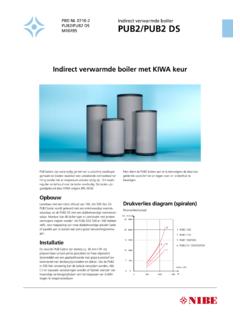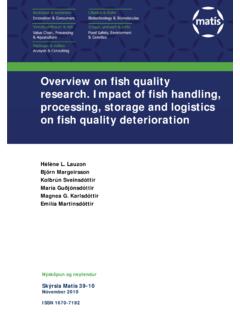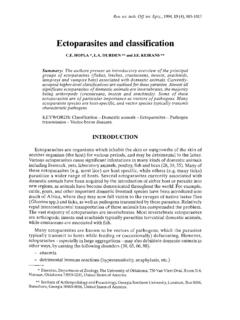Transcription of Table of Contents - Connecticut
1 Table of ContentsAcknowledgementsPrefaceMap of Connecticut with Site LocationsField MethodsElectrofishingThe Statewide Lake and Pond Electrofishing SurveyLake MappingAquatic Plant SurveyLAKE AND POND ECOLOGYThe Lake EnvironmentLake Productivity and ClassificationFood Chains/WebsThe Concept of Balance in Lake and Pond FisheriesDensity-Dependent Growth and Stockpiling of Fish PopulationsEffects of Balance vs. Imbalance on Lake EcosystemsCauses of Imbalance in Fish PopulationsFish HabitatHabitat AlterationAquatic VegetationMajor Groups of Aquatic PlantsEndangered Animals and PlantsIntroduced Animals and PlantsFish ParasitesCommon Parasites of Connecticut FishesFish KillsContaminants in FishLAKE AND POND FISH MANAGEMENTH istory of Fisheries Management in ConnecticutCOLDWATER FISHERIES MANAGEMENTT rout ManagementOther Coldwater SpeciesWARMWATER FISHERIES MANAGEMENTP otential Management Tools for Warmwater FisheriesPhysical Management ToolsFishing RegulationsLIFE HISTORIES OF COMMON LAKE AND POND FISHESD escriptions and Maps of Individual Lakes and PondsSite.
2 Andersons (Blue Lake)..North Pond ..Lisbon-Griswold-Canterbury ..Avery ..Babcock ..Ball Pond ..New Fairfield ..Bantam Haddam ..Batterson Park Pond .. (RI) ..Beachdale Pond .. Pond ..Union ..Billings ..Bolton Lake, Lower ..Bolton-Vernon ..Bolton Lake, ..Bolton Lake, ..Bolton Notch Pond .. (MA)..Burr ..Candlewood Fairfield-New Milford-Sherman ..Cedar ..Chamberlain River Reservoir ..Colebrook-Sandisfield/Tolland (MA) ..Congamond Lake ..(South, Middle, North Ponds) ..Suffield-Southwick (MA) ..Coventry Lake ..(Waumgumbaug Lake).. Pond ..East Lyme ..Dog ..Dooley Pond ..East Twin (Washining Lake)..Salisbury ..Gardner Lake .. Lyme ..Great Hill Falls Reservoir.
3 Pond .. (Shaw Lake) ..East Haddam ..Higganum Lake ..Winchester ..Holbrook ..Hopeville Pond .. Pond ..Jurovaty Pond ..(Bishop Swamp).. (Peck Pond)..Putnam-Thompson-Burrillville (RI)..Lake Kenosia .. (RI)..Lake of Hill Pond ..Ledyard-North Stonington ..Lake Pond ..(Schoolhouse Pond)..Thompson ..Long Stonington ..Maltby Lakes (1, 2 & 3)..West Hollow Reservoir (Naubesatuck Lake)..Mansfield-Windham ..Mashapaug (MA)..Lake McDonough ..(Compensating Reservoir).. River-West Pond ..Durham ..Mohawk .. Mono Pond .. Haddam ..Moosup Pond ..Ashford-Union ..Mount Tom ..Mudge (Silver Lake)..Sharon ..North Farms ..Pachaug Pond ..Pataconk (Russell Jennings Pond).
4 Chester ..Pataganset Lake ..East Lyme ..Pickerel Lake ..Colchester-East Acres Lyme ..Quaddick Reservoir ..Thompson ..Quinebaug (Wauregan Reservoir) .. Reservoir .. Cedar Lake ..Lebanon ..Rogers Lake ..Woodstock ..Lake Saltonstall ..Branford-East Reservoir ..Easton-Redding-Weston ..Shenipsit Lake .. (Peat Works Pond) .. Spectacle Pond ..Torrington ..Tyler ..Uncas Lake ..(Hog Pond)..Lyme ..Waramaug Branch Reservoir (Hogsback Reservoir) ..Colebrook-Hartland ..West Hill Hartford ..West Side ..West Thompson ..West Twin (Washinee Lake)..Salisbury ..Winchester Lake ..Winchester ..Wononscopomuc Lake (Lakeville Lake) ..Salisbury ..Wood Creek and Maps of Connecticut River Conn.
5 River Mainstem (North)..Enfield to River Mainstem (Central)..Hartford to Portland ..Wethersfield Point Cove (White Oak Cove).. Cove (Pecausett Pond) .. River Mainstem (South)..Haddam to Haddam ..Chapman Pond ..East Haddam ..Hamburg ..GlossaryAppendixGeneral ReferencesLIFE HISTORIES OF COMMON LAKE AND POND FISHESG amefishThe term gamefish refers to fishes that typically reach a large size and fight hard whencaught on rod and reel. They are aggressive fish with strong swimming abilities. For thesereasons, they are usually the fish most sought after by anglers. For the same reasons, gamefishare the apex predators in Connecticut lakes and ponds.
6 Apex predators are those that prey onsmaller animals and have few natural enemies because of their large size; thus they are at the topof the food web. Apex predators serve an important role in aquatic ecosystems by controlling thepopulations of smaller fish species. Thus, in most natural systems, a balance is achieved betweenpredators and prey species such that neither becomes so abundant that they overrun their and Smallmouth BassThe two black bass species are collectively the most sought-after gamefish in mostConnecticut lakes and ponds. Creel surveys conducted on three Connecticut lakes that were notstocked with trout found that 45 to 60 percent of the anglers were fishing for bass.
7 Many bassanglers practice catch-and-release, with more than half releasing all of the legal size (12 inches orgreater) fish caught. Competitive catch-and-release bass tournaments have also become verypopular in Connecticut , with the number of registered events increasing from 124 in 1986 tonearly 700 in regulations on bass in lakes and ponds are a 12-inch minimum length limit anda 6-fish (both bass species in aggregate) creel limit. A number of lakes have been designated as Bass Management Lakes and have special length and creel limits. Additional BassManagement Lakes were scheduled for 2002 (see current Connecticut Anglers Guide).Largemouth bass (Micropterus salmoides) are the largest members of the sunfish family(Centrarchidae).
8 Although not native to the state, the largemouth is our most widely distributed fish species and can be found in almost all Connecticut lakes and ponds. It is also the dominantpredator in most of our warmwater fish populations. It can thrive in a wide range of habitats, butprefers lakes that have at least a moderate amount of submerged vegetation. Largemouth bass Joseph Tomellerieat a variety of food items, including fish, crayfish and insects. Bass are generalists in theirfeeding strategies, sometimes lying near cover and using ambush tactics and sometimes activelyforaging for prey. They spawn between mid-May and June in Connecticut . The males buildsaucer-shaped nests in shallow water (2 to 8 feet) then guard the eggs and later the fry for severalweeks after spawning.
9 In Connecticut , it takes largemouth bass years on average to reach 12inches; they can live for 15 years or more. Largemouths commonly grow to 4 or 5 pounds and 18to 20 inches in length (state record: 12 pounds, 15 ounces).Largemouth bass are usually dark olive-green on their backs fading to a brassy green ontheir sides. A dark horizontal band extends from the gill cover to the base of the tail. As thename implies, they have exceptionally large mouths, with the end of the jaw extending to orbeyond the back of the bass (Micropterus dolomieu), also an introduced member of the sunfish(Centrarchidae) family, are more habitat-limited than largemouths, preferring clearer, deeperlakes with rocky shoal areas and less vegetative cover.
10 Because of this, smallmouths occur inonly half of Connecticut s lakes. They also are less tolerant of high water temperatures than arelargemouths (see Table 2) and are most often found in the deeper, cooler waters whentemperatures rise in summer. Smallmouth bass feed on a similar variety of food items aslargemouths; however, they are more likely to forage out in the open and are rarely associatedwith dense vegetative cover. Smallmouth spawning habits are similar to those of male builds a nest in shallow water during late spring (mid-May to June) and guards it forseveral weeks after the eggs hatch. Smallmouth bass are slower growing than largemouths,averaging years to reach 12 inches (state record: 7 pounds, 12 ounces).

















